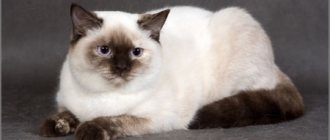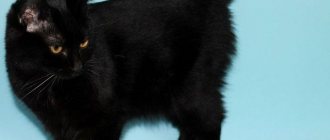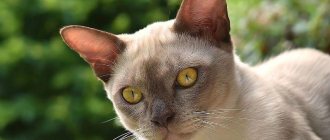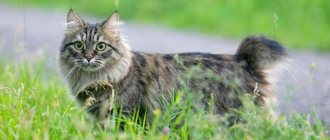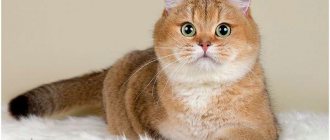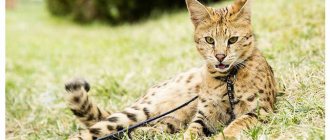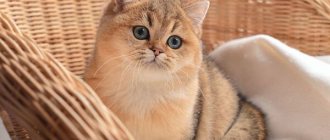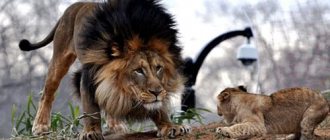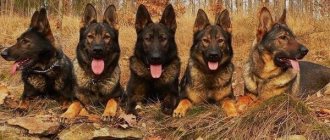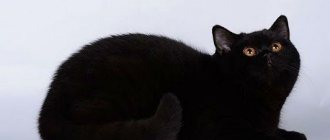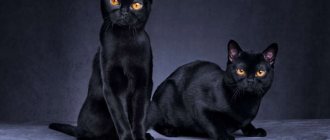British cats are pets that have won the hearts of true connoisseurs of beauty around the world. Among the British, there is a special group of colors that amaze with their beauty - chinchillas, smoky.
A unique feature of these colors is that the hairs on the cats’ coats are not completely dyed – only partially. The degree of coloring varies depending on the specific type. The rest of the hair, the undercoat, is pure white, silver or very light in color. This color option is usually called tipping. The attractiveness of this color is that the light coat is hidden under a brighter, base tone. When the cat moves, the effect of a smooth flow of one color into another appears.
The varieties of the British breed under consideration have their own characteristics and standards. When choosing a kitten or wanting to start breeding British cats (reviews from breeders state the fact that the chinchilla color is complex), you need to arm yourself with the relevant information. In this article you can find answers to many questions.
British chinchilla.
The British chinchilla is an artificially bred cat breed. It is a variety of the British one. The name speaks for itself - the fur of these cats is surprisingly similar to the soft, delicate coat of chinchillas. This color is one of the rarest and most expensive, but can be found among representatives of other cat breeds - Persian, as well as Burmese.
Scottish Fold SFS as blue smoke
The very first representative of the cat family with a unique fur coat was a cat named Shinny. Being British not only by the name of the breed, but also by origin, Shinnie was born in 1882. The parents were a Persian cat and a smoky-colored British cat. Further work on the development of the breed with amazing color was crowned with success; in 1889, another handsome cat appeared - a cat named Silver Lambkin. He was recognized as the ancestor of British chinchillas. Subsequently he won many awards and titles at international cat shows.
Variants of British chinchillas, description.
Since the chinchilla is a representative of the British, it has all the main characteristic features and standards of this breed. Chinchilla cats, like true representatives of the British breed, have a strong build and a large head. A striking feature of all British people is the dark rim around the eyes.
The pride of chinchillas, which sets them apart from other representatives of the British breed, is their luxurious fur. Quite short, has a dense structure, does not lie close to the body, and has a thick undercoat. The color of fur coats varies depending on the cat's color type.
Origin story
British cats are one of the oldest breeds. There are two legends about how the animals got to the island: according to one version, Roman legionnaires brought them to Foggy Albion; according to another, the cats sailed with French sailors, on whose ships they exterminated rodents. Be that as it may, the furry animals settled in England and became its full-fledged inhabitants. For a long time, they were ordinary street cats, selected only by Mother Nature. Due to the lack of an influx of new blood into the British population, genetic characteristics characteristic only of this breed have formed. The result was large animals with a massive body, charming round eyes and plush, densely stuffed fur that had water-repellent properties.
Due to living in a humid climate for a long time, the British have developed a dense, moisture-repellent fur coat.
Thanks to their intelligence, cleanliness and intelligence, British cats have gained the love and recognition of local residents. Then the work of specialists began on the formation of breed standards.
History of breeding
The British breed was first registered in 1898. Animals were very popular among English bohemians. But British cats of that time were mostly blue, which significantly reduced interest in the breed. At the beginning of the 20th century, people wanted something exotic, and they preferred Persians with a rich range of colors. Breeders, in order to restore the fading interest in the British breed, decided to diversify the color range of the British coat.
Animals of various colors began to be bred to increase interest in the breed
At first, selection work was carried out between new representatives of the breed, but the cats most often turned out were spotted forest colors or there were white spots, inclusions and medallions on the coat. Thus, it was not possible to escape from the basic genotype. Then felinologists began crossing British cats with Persians and individuals of other breeds similar in phenotype, due to which the color range of the British cats increased. In addition to the classic blue and smoky colors, the British have appeared in the most unusual color variations. In 1992, basic breed standards were established, which have remained virtually unchanged since then.
The modern British cat has more than 200 types of colors.
Pedigree features of the British cat
In order not to confuse a British cat with another breed, you should know its main distinguishing features.
Shiny raven-colored fur and sparkling amber eyes make the black Briton simply irresistible.
Table: external features of the breed
| Options | Description |
| Head | Round in front and in profile, with full cheeks, wide in the cheekbones, with a rounded structure of the underlying bone structures, sitting on a short thick neck. |
| Nose | Short, wide, straight. In profile, the transition from a rounded (convex) forehead to a straight nose is accompanied by a break (literally - break, which can also be translated as a depression, depression), which should be neither too shallow nor too pronounced. The color of the nose mirror directly depends on the color. |
| Chin | Strong, solid, well developed. The bite should be correct, and the lower point of the chin and the tip of the nose form a vertical line. |
| Muzzle | Well developed, with characteristically defined whisker pads. |
| Neck | Massive, short. There is a thick fold around the neck, characteristic only of this breed. |
| Ears | Small, with rounded ends. Set wide apart, emphasizing the round contours of the head. The outer surface of the ear is evenly covered with hair, the inner pubescence is moderately developed. |
| Eyes | Large, round, wide open. Placed straight. Eye color directly depends on color. Usually orange, color-point and white individuals have blue irises, chinchillas have blue to emerald irises. Some colors allow different eyes (heterochromia). Eye color should be bright and rich. |
| Body | Tightly built with a short, straight back. It appears squat due to short legs, with a wide and deep chest. Equally massive in the areas of the shoulders and croup. Medium size, not stretched. |
| Limbs | Round and strong, relatively short, with closed fingers. The forelimbs are straight and the same length as the hind limbs. |
| Paws | There are five toes on the front paws and four on the hind paws. The color of the pads directly depends on the color. |
| Tail | Thick, wide at the base, medium length, cone-shaped, with a rounded tip. |
| Wool |
The basic standards of a long-haired cat are fully consistent with the standards of a short-haired cat. |
| Weight |
|
| Lifespan | 10–15 years |
Characteristic
Such a fluffy will definitely get along with the people around him.
Black cats are considered the most obedient, kind and responsive, especially when compared with the characters of individuals of other colors. But this is only true for males. Smoky “emers” are often credited with being unobtrusive, but not shy either. They get along well with people and animals. Each breed has its own personality traits. For example, the Scottish representative knows how to make a show by begging for delicacies. The cat stands on its hind legs and, moving its front legs, looks intently into the eyes.
Genetics of color inheritance
There are so many colors of British cats that it’s easy to get confused among them. To organize the diversity of the color range, colors are divided into groups according to coat pattern, color and pigmentation. There are two basic colors that are directly involved in the formation of others:
- black;
- red.
Each color is formed due to a special substance - melanin. The pigment is found in a cat's hair in the form of microscopic granules that vary in shape, size and quantity. Melanin is divided into two chemical subtypes:
- zumelamine (gene B) - spherical granules that absorb light and form a black color (responsible for the black color and its derivatives);
- pheomelamin (gene A) - ellipsoidal granules that reflect light in the red range (producer of all shades of red).
The genes responsible for the offspring being red (O - orange) or black (o - not orange) are located on the X chromosome. The color of the future offspring is directly related to the gender of the parents. Females have two X chromosomes, and males have one, therefore, cats are responsible for three basic colors:
- OO - red;
- oo - black;
- Oo - tortoiseshell (red-black).
Genes located on the X chromosome are passed from mother to children. Accordingly, a red cat will not be able to give birth to black offspring, and a black cat will not produce red kittens. In cats, the color of the offspring depends on which gene is carried on the only chromosome (O or o), the choice is small - red or black. Tortoiseshell cats appear only in cases of pathology and are almost always infertile.
Cats can only be tricolor as a result of mutation.
If a cat has a tortoiseshell coloring, it means there is an extra X chromosome in his code. Characteristic gene mutations occur 1 time in 3 thousand individuals.
British black color
The dominant (dense) gene D and its companion, the recessive (diluted) gene d, are responsible for the color intensity. In order for the B gene (zumelamine) to appear and give a coal-black color, the cat must have the saturation gene D. Thus, for the formation of an intensely colored black color, dominant genes B and D must be present in the pet’s body. The recessive gene d dilutes the black color, makes it is washed out and gives lighter shades.
British black cats differ from their counterparts not only in color, but also in the quality of their coat - it is stiffer and has a characteristic, pronounced shine. This is due to the fact that the guard hair of black animals is more densely saturated with pigmentation. The signature plush coat is not typical for black individuals, but this is not considered a disadvantage.
Black British fur coats are denser and less plush.
The gene responsible for black color (zumelanin) is one of the ancient genes. Black color, along with tabby color, was often found in wild, undomesticated cats. This is why black and striped animals have a number of similar characteristics.
Description of color
The uniqueness of the color is explained by the work of an inhibitor gene that blocks the manifestation of the coloring pigment. The undercoat and bases of the hairs are devoid of it and are therefore white or lightly colored. The upper part of the guard hair is intensely colored black or charcoal. This type of coloring is commonly called tipping. The degree of concentrated blackening reaches 2/3 or 4/5 of the length of the hair, but not less than 50%. Some breeds are characterized by the presence of a light “collar” around the neck. The complex color looks like a solid, monochromatic one, but when the animal moves, the villi diverge, exposing the light down, and the impression of living, iridescent fur is created. Owners of cats with such wealth note that periods of pronounced pubescence of the pet provide the most mesmerizing spectacle. Kittens may have uneven coat color, which evens out as they grow older.
Black color standards
Black color belongs to the group of solid shades, which are also called solid. The name comes from the English solid - solid, solid. Solid colors are divided into seven main groups, each of which has its own code according to European standards.
Table: coding of the main solid colors of the British cat
| Color | Code |
| Blue | BRI a |
| Black | BRI n |
| Lilac | BRI c |
| Chocolate | BRI b |
| Cream | BRI e |
| White | BRI w |
| Red | BRI d |
Black representatives of the British breed are incredibly beautiful and attractive, but quite difficult to obtain the ideal color.
A black British cat's nose and paw pads should be the same color as their fur.
Expert requirements for black color:
- wool - evenly dyed to the very root, thick charcoal color; the undercoat should blend in with the main tone of the coat, shine is allowed;
- paw pads are black or charcoal in color;
- nose mirror - black;
- eyes: copper;
- orange;
- golden.
How to choose a British dog with black coat
When buying a black British kitten, even from the most professional breeders, you cannot be sure that it will grow into a pet with high-quality black fur. The main problem is that small “emers” tend to fade. The pre-blooming stage lasts until the age of sexual maturity. During this period, kittens may have blurry patterns, brown undercoat, or so-called gray hair. Only at six to seven months can you be sure that the animal’s color has acquired a rich coal-black color.
Felinologists believe that smoky kittens during puberty have every chance of becoming the owner of luxurious raven-colored fur.
Don't panic if you find single, unpainted spots on your kitten's fur. Gradually, these hairs will fall out on their own, but sometimes they stay in the neck area for a long time and finally leave the animal’s coat after the first mating.
Only during puberty can you understand whether the British fur coat will be a rich charcoal color
In order not to make a mistake with the color and to be sure to become the owner of a black British cat, it is better to take an already grown-up kitten whose fur is sufficiently formed.
Black British eye color
All British cats are born with blue eyes, but at the age of three to four months they change color, acquiring their final color. Eye saturation is determined differently for everyone. Blue-eyed, black-colored Britons do not exist in nature, since the recessive blue tint cannot appear in combination with the dominant black coat.
The eyes of a black British cat at the age of three to four months lose their blue tint and acquire their final color
Breeders believe that the brighter the kittens' eyes, the less intense the color will be when they grow up. Conversely, an iris of gray shades suggests the most intense color, which is so valued in the British breed.
The most preferred eye color of a black Briton is a rich orange tint.
Breeding British black kittens
Even for experienced breeders, it is very difficult to obtain high-quality black offspring, so it is best to carefully think through the breeding program in advance. Choosing the right parent pair is the main issue in breeding work. It is desirable that manufacturers meet certain requirements:
- both had a solid black color;
- in their pedigree there were as few ancestors with lightened colors as possible;
- Dominant and recessive color genes of British breeds were taken into account.
It is better not to breed black and blue cats with the same “rust” color. Cats with warm chocolate and lilac colors, as well as tabby colors in warm or “golden” tones, are undesirable for mating with black individuals, since these mating options are fraught with the appearance of reddish tones in black offspring.
I. Shustrova
https://do.gendocs.ru/docs/index-267867.html?page=5#6583271
Another necessary condition for the appearance of high-quality offspring is that both sires must be healthy at the time of mating, vaccinated on time and treated for parasites.
Perhaps one of these kittens will become the owner of a luxurious plain coat of jet black color
In order not to get the opposite result to the desired one, it is best to contact a felinologist. They will make a high-quality genetic calculation of the animal and select a suitable match for it. These tests are carried out taking into account the pedigrees of the potential parents.
Special compatibility tables for producers of different colors compiled in Russian nurseries will help you avoid getting a defective litter:
- when mating animals of a solid color with bicolors (tricolors), the offspring consists of 50% kittens of a solid color and 50% of bicolors (tricolors);
- when mating two bicolors (bicolor and tricolor), the litter will consist of: 50% bicolors (tricolors);
- 25% of kittens are solid color;
- 25% harlequin (5/6 part of the body is white).
Table: results of colors of black kittens from parents without agouti factor (uneven coloring of hairs)
| Cat | Cat | Kittens | |
| Boys | Girls | ||
| Black | Black |
|
|
| Black | Blue |
|
|
| Black | Redhead |
|
|
| Black | Cream |
|
|
| Black | Tortoiseshell |
|
|
| Black | Blue-cream |
|
|
| Blue | Black |
|
|
| Blue | Tortoiseshell |
|
|
| Ginger | Black |
|
|
| Ginger | Blue |
|
|
| Ginger | Tortoiseshell |
|
|
| Ginger | Blue-cream |
|
|
| Cream | Black |
|
|
| Cream | Tortoiseshell |
|
|
My blue British girl has a blue mother and a black father. The litter included one girl (my pet) and two black cats. When we arrived to pick up our cat, I saw her father for the first time. I couldn't even imagine how beautiful black British people are. These are graceful cats with incredible energy. It was simply impossible to take my eyes off my Tsili’s father. Shiny fur, bright eyes the color of freshly collected buckwheat honey. Mars (that’s the cat’s name) watched carefully as we put Tsilya in the carrier and accompanied us all the way to the door. He was probably assessing the new parents. Right at the exit, I risked petting the cat, and he didn’t resist. The hostess was even surprised, saying that Marsyusha was reluctant to make contact with strangers. The fur coat of a black cat is indeed tougher and denser than that of relatives of other colors. Our Tsili’s fur resembles a soft tsigeya, while Mars’s is like a natural carpet, but very well-groomed and pleasant to the touch. We also communicate with the owner of a cat from the same litter as our pet. Steve is a black, imposing cat, a real copy of his father, only with lemon-colored eyes. By nature, our brother Tsili is softer and more flexible. He calmly goes to communicate with everyone who enters the house and really loves tactile contact with the owners, which cannot be said about our too independent girl.
Breeding work
It is very difficult to obtain high-quality black offspring in the British breed, and sometimes even experienced professionals cannot predict the result in advance.
Breeding Black British
The choice of a breeding pair is the main issue of any breeding. In our case, it is desirable that future parents meet the following requirements:
- both had a standard black color - even, without spots or shades of color;
- were already untied and previously gave birth to offspring;
- had multigenerational pedigrees from which heredity could be studied.
The ideal parent pair to produce black offspring should be black in color
It goes without saying that at the time of mating both animals must be in good physical and psychological shape, completely healthy, promptly vaccinated and treated for all types of parasites.
Black kittens can be produced by parents with any coat color if they are carriers of the black gene. But a black father and mother, of course, give a much greater chance of getting black babies in the litter. Their wool will be of high quality, and the color will be rich if the pedigrees of the producers contain as few ancestors as possible with light colors: blue, peach, etc. In this case, the presence of striped, spotted and “marbled” ancestors is even more undesirable.
This combination may well produce black offspring, especially if the black parent is prepotent
An important specificity of the British, which must be taken into account when selecting a parent pair, is the presence in this breed of two blood groups, A and B, which it is very advisable not to mix when mating. If you do not adhere to this rule, the litter will be born healthy, but may die within three days. This is due to the fact that maternal colostrum produces special bodies that have a detrimental effect on the blood of “hybrid” babies. In this case, kittens can be saved by immediately switching to artificial feeding.
All British dogs grow and develop very quickly, but puberty comes quite late for them - as, indeed, for all large breeds. Only by four, and in some cases by five years, animals are fully formed physically and psychologically. So early matings are contraindicated for this breed.
Of course, you shouldn’t breed a cat every time she’s in heat - she needs to fully recover from the joys of motherhood. The optimal frequency of successful matings for a British cat is three times in two years. Litters are rarely large, and British cats make very good mothers.
British women are very caring mothers
Issues of castration and sterilization
The British breed usually has high hormonal levels. Therefore, when you decide to take a little Briton into your home, decide in advance whether you plan to get offspring from him in the future - by the way, the class of the animal and its price depend on this. If you are not going to engage in exhibitions and breeding work, it is better to spay or neuter your pet.
This operation will help maintain health, which is especially important for a cat. If she does not regularly bear offspring, then the reproductive system becomes vulnerable to the development of inflammatory processes, which is fraught with the appearance of very dangerous diseases - pyometra and even oncology. After sterilization, animals become much calmer, and cats stop marking their territory.
The optimal age for sterilizing a cat is from nine months to one and a half years, when regular estrus has already begun, but there has been no birth. It is better to castrate a cat at about one year of age.
If you do not plan to breed, sterilize the animal in a timely manner.
Take surgery very seriously. Sterilization (especially of cats) is a full-fledged operation that is performed under general anesthesia and requires time and attention for rehabilitation. Trust this procedure only to experienced specialists and carry it out in a veterinary clinic and not at home. The recovery process must also take place under the constant supervision and control of a veterinarian.
Black British coat care
The coat of a black British cat will look perfect if you follow some rules:
- Black Britons, like everyone else, need proper nutrition. The diet should be balanced and varied. There are two feeding options: natural food or ready-made food (super premium line). Breeders do not recommend mixing dry food and natural products, as this can lead to gastrointestinal diseases in the animal. If a cat eats natural products, then its menu should include the following products:
- chilled lean meat or poultry breast;
- boiled sea fish;
- dairy products;
- vegetables and finely chopped greens;
- poultry eggs;
- kelp algae, which maintains the black color of the coat.
Algae maintains the black color of the British coat
- Since the coat of the black representative of the British breed is darker and coarser than that of its relatives, it gets dirty less and is easier to clean. Therefore, you should bathe your pet no more than once every six months. The Briton should be washed with special shampoos, preferably premium ones. Reasons for giving your pet an emergency bath:
- participation in exhibitions and competitions;
- severe contamination of the wool with something sticky, sticky or toxic;
- independent visit to the street;
The British are very clean animals, so they should not be bathed often.
- getting rid of tangles;
- removal of stuck impurities.
- The Black Briton needs to be brushed once a week with a slicker brush or a special fine-toothed comb. During molting, the animal needs to be scratched more often - about once every two to three days. A cat should be taught hygiene procedures from a very young age, otherwise the pet will be reluctant to accept them.
- For large British dogs, you should choose a spacious and comfortable tray and filler that does not stick to the animal’s fur.
- The Black British cat, like any domestic cat, needs annual vaccination and prevention of parasites.
British cats are prone to obesity, so you need to carefully ensure that they do not overeat. The slightest disruption in health can lead to a deterioration in the quality of the coat and loss of natural shine.
When we took our British cat from the breeders, they warned us that it was better to feed the animal natural products. The diet must include raw lean meat. The breeder advised us to immediately cut the purchased veal into long pieces and package it in portions. Before eating, the meat must be doused with boiling water. When chewing long bars, British children develop a correct bite and plump, as if stuffed cheeks, forming a unique “Cheshire smile.”
How to care for a black British man
The popularity of Black British dogs is explained not only by their spectacular appearance and positive character, but also by the ease of keeping this breed at home.
Hygiene
The coat of Black British cats is easier to care for than that of other representatives of the breed, since it is stiff and elastic, gets dirty less and is easier to clean itself. Some owners argue that these cats don’t need to be bathed at all - they themselves perfectly resolve all issues of their own hygiene. But it is not so.
Yes, the British constantly monitor the cleanliness of their fur coat, but sometimes it still needs to be washed using special cat shampoos. They are bathed infrequently - once every six months. An exception to this rule is when preparing for a show or when your pet's fur is very dirty.
Black British cats love to wash themselves
Human shampoos cannot be used on cats - dandruff or allergic reactions and dermatoses may occur. Black British cats do well with cat shampoos for dark coats. Various manufacturers have such cosmetics, but it is better to give preference to expensive brands - cheaper options can deprive the British fur of its wonderful shine.
Advice from my own experience: a brownish tint on black wool can be eliminated by using shampoos... for white wool. These products usually do not have a banal lightening effect - but they effectively remove all elements of yellowness and brownness from the fur, making the natural color brighter. When choosing such a shampoo, pay attention to its composition - the more natural it is, the better.
Don't bathe your pet too often - it won't benefit his coat.
For British Shorthairs, one brushing per week is enough; shedding hair needs to be brushed more often. During periods of seasonal molting, the fur coat should be combed three times a week using a furminator. At this time, it is recommended to introduce vitamin supplements into the diet that are produced specifically for this breed.
Ears, eyes, teeth and claws require special attention - everything that the animal cannot care for on its own. Ordinary hygiene involves wiping the inner surface of the ears and the perimeter around the eyes with cotton pads lightly dipped in cool boiled water or a special lotion.
Eyes need to be cleaned daily, ears weekly, without going deep into the ear canal. To clean teeth, use special pastes and brushes that are sold in pet stores. Claws, if they do not grind down on their own, are trimmed as they grow. It is advisable to lubricate the claw sections with antifungal drugs.
Feeding
The British can boast of an excellent appetite and pickiness in food. The black Briton is by no means an exception in this sense. Both high-quality dry food and natural nutrition are suitable for him. The pet industry offers a large selection of ready-made foods designed specifically for British cats - they are available in the lines of many well-known brands.
If your pets are sterilized or lead a sedentary lifestyle, you will need to pay special attention to the selection of food - it should be of high quality, but low in calories. It is impossible to overfeed the British, representatives of this breed are prone to obesity. But water, fresh and clean, should always be in sufficient quantities.
It is more difficult to choose a natural diet for a black Briton - so that it is healthy, varied and balanced. It is recommended to include the following products in the cat's menu:
- boneless veal or poultry;
- boiled sea fish;
- low-fat fermented milk products;
- quail eggs;
- boiled or fresh vegetables.
Fresh meat should make up at least half of a black Briton's diet
It is very useful to give your pet seaweed - kelp - once a week, which helps improve the quality of the coat and saturate the black color. Important: kelp must be fresh or dried - pickled seaweed should not be given. Pickled, spicy, smoked, fatty and fried foods are harmful to cat digestion. You also can’t “pamper” the British with sweets and fresh baked goods.
Toilet
Smart British kittens start using the litter box early. They are very clean and easy to train, so in their new place of residence there are usually no problems in this regard. The only thing worth paying attention to is that the tray should be quite spacious and comfortable, since British cats have impressive dimensions. Usually, closed toilets are purchased for this breed.
Trust the choice of litter for the tray to the preferences of your pet. Find out in a timely manner from the breeder what type of litter the kitten has gotten used to, and buy the same one for him.
For long-haired British cats, wood and low-quality mineral fillers are not recommended - when wet, they turn into a sticky substance that stains the elongated fur on the paws and then spreads throughout the house.
Features of participation in the exhibition
Any British cat that meets the stated standards can take part in the exhibition. It is important that the animal is healthy, has no external physical defects and has a calm emotional background. A pet that is aggressive or very frightened will most likely face disqualification.
Preparing the appearance
It is best to start preparing your pet for the exhibition in advance:
- If a Black British cat's coat feels greasy to the touch or has lost its characteristic shine, you should bathe the cat with a special shampoo a few days before the event. For animals with dark fur, the Royal Groom Black Pearl cosmetics line and similar ones are ideal. To improve the quality of the fur coat, it is recommended to use conditioners of the same brands.
- To get rid of tail fat, it is better to clean the animal’s anal glands in advance.
- The cat's eyes and ears should be perfectly clean, without discharge, scabs or suppuration.
- Nails need to be trimmed carefully.
Nails will need to be trimmed before the show.
- Brush your teeth at least three days before the exhibition.
- It is strictly prohibited to tint or tint the animal.
- If there are single white hairs on the fur, they need to be removed.
- To avoid fading of the fur, show animals should not be allowed to sunbathe.
The cat will have to be banned from sunbathing before the exhibition
At the show, cats are evaluated on a 100-point system.
Table: scoring system according to association standards
| Options | WCF | FIFE | CFA |
| Body | 20 | 20 | 35 |
| Head | 30 | 30 | 25 |
| Wool | 10 | 10 | 20 |
| Color | 35 | 35 | 20 |
| Condition | 5 | 5 | — |
The judges place the main emphasis on the type of head, quality of color and texture of the animal's coat.
Black Britons not only participate in exhibitions, but also quite often take prizes
Disqualification of a black British man
Reasons why a black British cat is disqualified:
- white hairs, medallions, brown or gray undercoat;
- pale, inappropriate eye color or greenish rim around the iris in adults;
- non-black color of paw pads or nose;
- non-standard number of fingers;
- defects and pathologies of the tail, including kinks and kinks;
- long or fluffy coat, too long or light undercoat;
- significant violations of the dental system;
- overshot or undershot exceeding 2 mm.
At the exhibition you can not only receive well-deserved awards, but also find out the opinion of experts about the animal, get the necessary recommendations, and also find a worthy pair for mating. But if the judges did not rate the cat very highly, there is no reason to be upset, because for a loving owner, his pet has practically no shortcomings.
